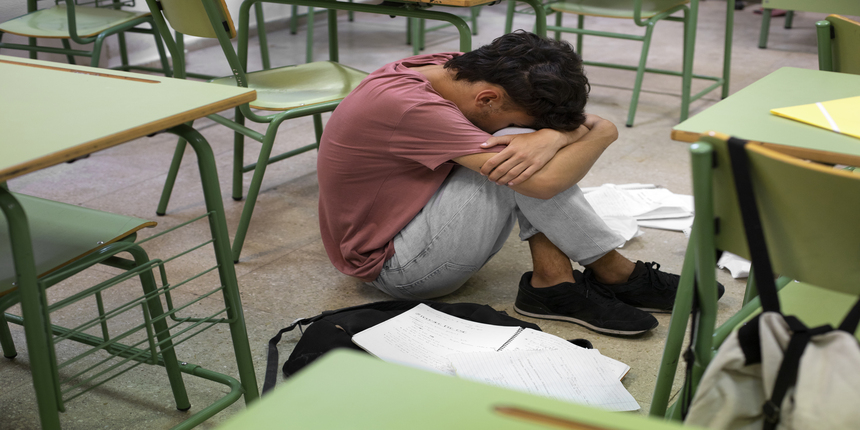Task force, warning signs: Education ministry drafts suicide-prevention guidelines for schools
R. Radhika | October 4, 2023 | 11:27 AM IST | 3 mins read
Education ministry’s guidelines, UMMEED, stress on collaboration between school, parents and community; recommend ‘School Wellness Teams’.

NEW DELHI: Acting on the rapid rise in student suicides in the country, the ministy of education has drafted guidelines directed towards prevention of suicide in schools.
With the motto, “Every Child Matters”, the guidelines titled UMMEED – Understand, Motivate, Manage, Empathise, Empower, Develop – seek to guide schools for enhancing sensitivity, understanding, and providing support in case of reported self-harm.
Emphasising on collaboration between school, parents and community, the draft guidelines issued on Tuesday, suggest measures to foster societal support as a critical strategy to reduce the stigma associated with suicidal behaviour.
Factors influencing suicidal behaviour, risk factors, misconception and myths around suicide have been categorically addressed in the guidelines for “accurate identification of warning signs of suicide.”
The draft document suggests identifying the warning signs as such as history of depression, child abuse, previous attempts of self harm, poor self esteem among students to prevent self-harm among school children. “ Identifying the warning signs is important to provide timely support to students, as it is these signs which would lead to identifying those at risk of harming themselves,” the document states.
Recognising a collective responsibility to prevent suicides, the guidelines suggests measures to identify feelings, actions and behaviour indicative of students at risk at school, home and at community level.
Suicide prevention in schools
The school authorities have been directed to be cognizant of the causes of distress among students like unrealistic expectations in academics, pressure to perform well in competitive examinations, loss of loved ones, criticism or bullying by family members or peers. The year 2023 saw the highest number of student suicides –22 so far– with two ending their lives in a gap of a few hours on August 27. Last year, the figure was 15.
Suggesting a comprehensive approach to prevent self-harm among students, the draft recommends constituting a School Wellness Team (SWT) led by the school principal along with other members like school counsellors, a school medical officer and teachers oriented in handling crisis situations. Any students who show signs of risk will be reported to the SWT.
“The SWT will also play an important role in implementation of school activities directed towards creating awareness about mental well-being, leading towards suicide prevention. However, SWT alone will not suffice in a school’s efforts towards prevention of suicide and would require the support of all stakeholders,” the guidelines state.
The SWT, according to the draft, should include members displaying characteristics of sensitivity, trustworthiness and amicability. The team will also be reconstituted on a regular basis and will be held accountable to stakeholders on an annual basis.
To promote well-being of students, the draft suggests encouraging peer support, opening channels for free expression and integrating mental wellbeing in school functioning. Daily interactions, open discussions, assembly time, different programmes, subject-teaching at schools are some of the suggested activities.
Also Read| Kota Suicides: star, leader, repeater, enthusiast; experts warn against batch segregation
Helping students at risk
The guidelines also suggest taking immediate action if a student displays any warning signs even once. Encouraging students to talk in a calm environment, attentive listening, and earning student’s confidence without judging the situation are some of the first response measures suggested in the guidelines.
The guidelines call for a collaborative effort among peers, friends, classmates, teachers and other school staff to prevent suicide. For an effective strategy, the guidelines suggest capacity building and sensitization of all stakeholders to take immediate action.
“The reasons for suicide are complex and differ from individual to individual. It is also important to know that at times, suicide can be an impulsive act that can take place due to immediate stress-causing events. Every suicide is a clear reminder of compromised mental well-being at the individual’s level and ineffectiveness of the preventive and well-being promoting mechanisms around the individual,” the guidelines states.
Maintaining records and a follow-up with the student risk is also one of the critical suggestions in the guidelines. “This is an essential step required in not only ensuring the safety of the student
but also to understand the challenges. The SWT members need to connect with parents after
the incident to follow up on the student. This understanding would help in extending need based support to the student and avoid any such situation in the future,” the draft said.
If you, or anyone you know, needs help, AASRA has a list of resources here: http://www.aasra.info/helpline.html
Follow us for the latest education news on colleges and universities, admission, courses, exams, research, education policies, study abroad and more..
To get in touch, write to us at news@careers360.com.
Next Story
]‘Big loss to colleges’: Over 5,000 seats vacant after 4 rounds of DU UG seat allocation
Delhi University teachers said the large number of DU vacant seats is ‘criminal’ and the CSAS process has become less transparent compared to earlier admission policy. DU final special spot round 2023 seat allotment result today at admission.uod.ac.in.
R. Radhika